Vera Olkhovskaya
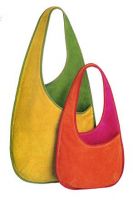 Ready-made free patterns of bags are made in full size. No seam allowances.
Ready-made free patterns of bags are made in full size. No seam allowances.
File format *.pdf
The pattern is suitable for self-printing and for printing in printing centers
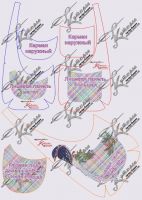 To download the pattern file for free, click on the link next to the words "download attachment".
To download the pattern file for free, click on the link next to the words "download attachment".
How to print life size bag patterns at home
All rights to patterns belong to Vera Olkhovskaya.
Duplication and resale without the consent of the copyright holder are punishable by law.
The copyright for the embroidery designs belongs to Anibell and used with her consent.
Description of bag patterns
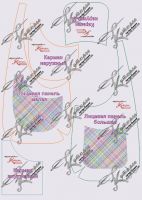 The set of templates includes:
The set of templates includes:
- details of the "front panels" of large ones - for a large and for a small bag;
- details of the "front panels" of small ones - for a large and for a small bag;
- pocket details for both bags.
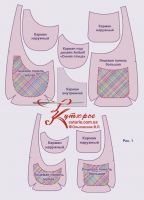 For sewing these bags thick fabrics or leather in contrasting colors should be used.
For sewing these bags thick fabrics or leather in contrasting colors should be used.
Coarse linen, heavy denim, and synthetic fabrics of similar thickness and weight will work. In addition to the materials listed, you can use upholstery fabrics and leather, as well as special materials.
As a butt, so that the bags do not deform, a dense doubler or shabrak is suitable. Soft bags can be sewn without padding.
In addition, for processing slices of parts, you will need an oblique trim for edging slices.
 The fabric consumption can be calculated both by the length and the width of the front panel part, that is, it will be 35 or 70 cm for a large bag and 26 or 53 for a small bag. This is with a width of 140 - 150 cm. Please note that the bag is "two-layer". Consumption is indicated for one "layer" of the bag.
The fabric consumption can be calculated both by the length and the width of the front panel part, that is, it will be 35 or 70 cm for a large bag and 26 or 53 for a small bag. This is with a width of 140 - 150 cm. Please note that the bag is "two-layer". Consumption is indicated for one "layer" of the bag.
It is advisable to make an oblique trim for processing sections yourself, since the commercially available one does not have the necessary wear resistance.
In addition, it is recommended to use a magnetic lock, buttons or velcro, so that the bag does not open.
How to sew bags with your own hands
First you need to measure the length of the sections that we will edge and make a bias tape.
Please note that we will need a double bias trim, which you will use to edge the cut of the bag without the use of tools. Thus, the width of the strip under the inlay should be about 7 cm. The fabric for it needs to be strong and durable, but thin enough.
We cut out doublerin or other dubbing with a negative allowance - minus 1 cm, to facilitate edging.
But, if you use a stitch, then it is better to simply mark the bag on the fabric before stitching and do not cut it out until the stitch is finished. Interlining materials should also not be cut before the end of the stitch. In this case, doublerin can not be used, since the stitch will give the necessary rigidity and density of the “layer”.
If we talk about cutting the bag in more detail, first we cut out the details of the “front panels” of one color, then another color. In this case, it is very important not to turn the panels over. To give the handle greater strength, it is advisable to shift the seam of one of the “layers”, and after joining, duplicate the handle separately.
If you are sewing a bag from fabric, we cut out tucks with a “house” allowance.
Cut out pockets from leftovers.
We cut out pockets for edging without seam allowances. Patch pockets - with allowances and separately we make cardboard patterns for ironing.
Watch the video master class on sewing patch pockets
Sewing Tips for Bags
The inner pocket for a large bag can be made both from the “top” fabric and from the edging fabric or from the lining fabric.
Do not forget, if you are sewing a bag from fabric, we cut out tucks with a “house” allowance, if from leather, then the allowance is not needed. For a quilted bag - a “house” above the tuck and after processing it is better to cut off the allowance and “cover” it with an oblique trim from the wrong side.
The use of machine embroidery designs can somewhat change the technology of cutting and sewing. Let's consider this question on the example of using Anibell embroidery designs
“Cat” and “Owl” are best embroidered before cutting. Of course, you can use the appliqué technique by embroidering these designs on linen or denim and, after completing the fringe, apply and stitch on the finished pocket to the pocket blank.
For the "Blue Bird" it is better to change the sequence by embroidering it when the pocket is already connected to the "front panel". And additional leaves and twigs are best done using the appliqué technique on a pocket blank.
When all the pockets are processed, it is necessary to process the darts, attach the locks and connect the "front panels" of one color with the front panels of the second color along the cut of the entrance to the bag. Then, having turned over this cut, connect and turn over the outer cut.
Sew an embroidered shirt - patterns
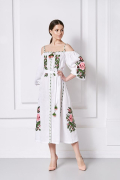



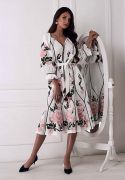
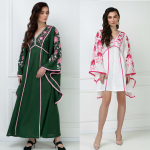

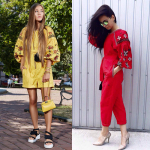

 Join my community on Viber...
Join my community on Viber...










